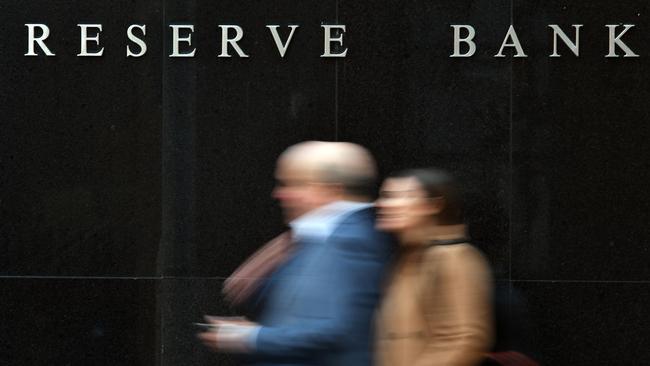RBA clears way for June rate cut
The RBA has cleared a path to an interest-rate cut in June, amid a weakening jobs market.

The Reserve Bank of Australia has cleared a path to an interest-rate cut in June, with minutes the central bank’s latest board meeting showing members believed deterioration in the job market would warrant the first reduction since 2016.
Data last week, days after the RBA board in early May decided to hold the official cash rate steady, showed the unemployment rate has risen to 5.2 per cent in April, up from 4.9 per cent in February, while wages growth had also stalled at low levels.
“Members considered the scenario where there was no further improvement in the labour market in the period ahead, recognising that in those circumstances a decrease in the cash rate would likely be appropriate,” the minutes from its May 7 board meeting said.
A surprise decision today by the Australian Prudential Regulation Authority to dump its 7 per cent interest rate buffer that borrowers were required to clear in order to gain approval for mortgages has also spurred expectations the RBA is gearing up to give a potential interest rate cut further fire power.
“The effect on the economy of lower interest rates could be expected to be smaller than in the past, given the high level of household debt and the adjustment that was occurring in housing markets,” the RBA minutes said.
“Nevertheless, a lower level of interest rates could still be expected to support the economy through a depreciation of the exchange rate and by reducing required interest payments on borrowing, freeing up cash for other expenditure.”
The cash rate has been on hold at a record low of 1.5 per cent since 2016 and, amid the gloomy economic outlook, financial markets are now pricing in two cuts by the end of the year — a projection the RBA acknowledged it has now factored into its own economic forecasts, which were downgraded earlier this month.
RBA governor Philip Lowe, who was to deliver a speech this afternoon, has pinned any future movements in the cash rate to the health of the unemployment rate, after the headline inflation rate — a key reading on the health of the economy — stalled at zero per cent in the March quarter.
The dumping of APRA’s mortgage rate buffer, which will allow banks to approve loans to borrowers who didn’t meet previous hurdles on repayments, will “importantly, enhance the effectiveness of the transmission of Reserve Bank rate cuts through the new borrowing channel”, said National Australia Bank economist Kieran Davies.
ANZ chief economist David Plank said APRA’s policy change could be “seen as lessening the need” for a near-term cut to interest rates. “An alternative take is that the change will enhance the power of a rate cut and so make one more likely,” Mr Plank said.
With the RBA now conceding that the jobless rate will take longer to fall below 5 per cent than previously expected, it is likely to trigger a series of cuts to the official cash rate, which will take it to a new record low of just one per cent. Just days before the election, the headline unemployment rate jumped to 5.2 per cent, off its recent 7-year low of 4.9 per cent.
As house prices continue to fall across the country, amid weaker than expected growth in lending, household consumption has come under severe pressure and has begun filtering through to lower rates of construction, retail sales and care sales.
House prices are down almost 10 per cent across the country, with falls of more than 14 per cent in Sydney and 11 per cent in Melbourne. Both cities account for nearly half of the country’s housing stock.
According to the Australian Bureau of Statistics, total home loan demand slumped 3 per cent in April, taking the year-on-year slide to 18 per cent.
Credit growth has now tumbled 26 per cent since late 2017 as banks tighten the screws on loan applicants and investors withdraw from the market.
The ABS’s measure of underlying inflation slowed to 1.4 per cent during the year through March, well below the RBA’s target band of 2 to 3 per cent.
“The recent (inflation) data had led the bank to reassess the disinflationary effects of the weak housing market,” the RBA minutes said.
“Combined with the lower GDP growth outlook, this had led to a downward revision to the inflation outlook, although there was also some uncertainty about the persistence of downward pressure from utilities and administered price changes and the effect of housing market weakness.
“Loan approvals also appeared to have stabilised in recent months. Members noted that, although lending practices were tighter than they had been for some time, the decline in housing credit growth over the preceding year had been driven largely by weaker demand for finance, associated with the decline in housing prices.”
The commentary opens the door for the RBA to cut interest rates at its next policy meeting on June 4. It would take the official cash rate to a record low 1.25 per cent from 1.50 per cent, where it has sat since August 2016.
A recent deterioration in trade relations between the US and the China was also cited as a risk to the economy, with around one quarter of all Australian exports heading to China.
The shift toward an interest-rate cut by the RBA has occurred rapidly over recent months, with policy makers surprised by a dramatic slowdown in the economy through the second half of 2018.
Still, the minutes showed the RBA board discussed upside risks to the economy, including the likely boost to household disposable income from tax cuts, set to be delivered mid-year.
With Dow Jones Newswires



